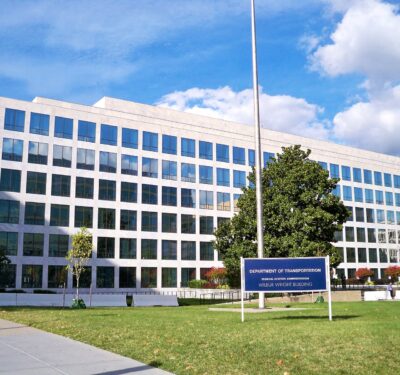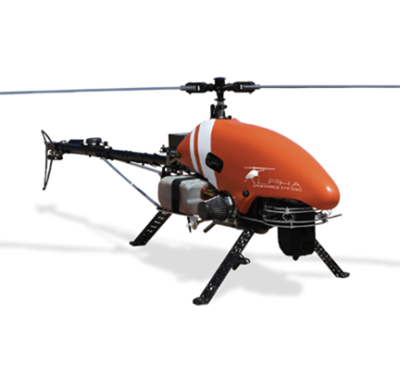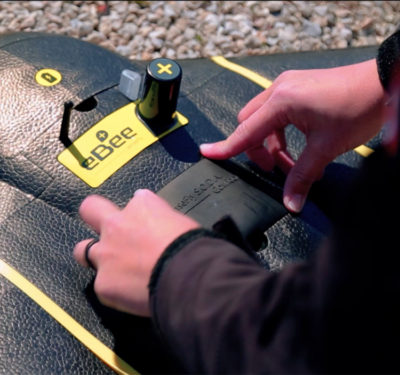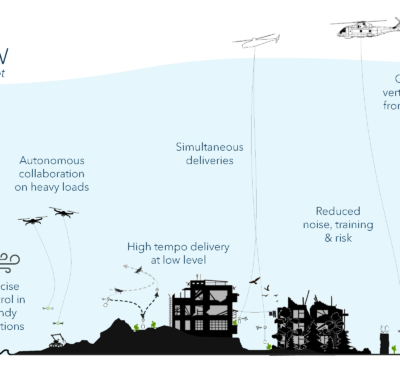The White House has found a way to head off a fight with local officials, please industry with expanded research and deflect pressure for more demanding rule-making all while keeping pretty much everyone happy and getting other folks to foot the bill. While clearly a masterful piece of political carftsmanship, the Integration Pilot Program (IP2) has the potential to be a practical success as well. If it works as planned, and expands as hoped, IP2 could evolve into a broad rapid-prototyping network that could draw participants from all around the world.
Announced by President Trump on October 25, the IP2 program would have the Federal Aviation Administration (FAA) work out deals with a minimum of five teams of problem solvers headed up by state, local or tribal entities. These entities are to partner with the private sector in what appears to be a nearly wide-open, three-year effort to hammer out real-world drone and flight-support technology plus the policy and operational details needed to make unmanned aircraft systems (UAS) operation both practical and acceptable to the public.
Though a lot of the fine print is still being worked out, the pilot program supports three broad objectives:
(1) Test and evaluate various models of state, local, and tribal government involvement in the development and enforcement of federal regulations for UAS operations;
(2) Encourage UAS owners and operators to develop and safely test new and innovative UAS concepts of operations; and
(3) Inform the development of future federal guidelines and regulatory decisions on UAS operations nationwide.
“The integration of drones into our national airspace will be the biggest technical challenge to aviation since the beginning of the jet age,” said Elaine Chao, secretary of the Department of Transportation, at the official launch of the program in Washington on November 2. “Our job is to help prepare the way for this new technology so that they can be safely deployed and usher in a new era of aviation service, accessibility and capability.”
The rapid-fire implementation plan for IP2 means the program is unlikely to be slowed by an extended period of federal coordination, requirements setting or other forms of delay by rumination. While new rules will doubtlessly (and appropriately) go through those processes, the White House has given DOT and the FAA just 180 days to find and sign up those first five teams.
With a stroke of a pen the Trump Administration has launched what could become a nation-wide skunk works for commercial drone implementation.
Skunk Works
Lockheed Martin’s Skunk Works, that is its Advanced Development Programs (ADP) division, is renowned for its speed, creative problem solving and the independence given to its engineering teams. The Skunk Works designed and delivered the P-80 Shooting Star fighter, the first turbojet-powered combat aircraft, in just 143 days. It developed the U-2 spy plane and, more recently, the stealthy F-117 Nighthawk.
The FAA, which appears to be genuinely enthusiastic, wants to cast the IP2 teams in the same fast-and-clever mold. The agency has long been under intense pressure to issue new rules allowing flights over people, night flights and beyond visual line of sight (BVLOS) missions—all activities widely seen as essential if the drone industry is to become profitable. FAA needs more data to do that but, by all accounts, has been hamstrung by a shortage of resources. It now has a way to get that research done.
That foundational research in IP2 is “one of the things most important to us,” stressed Earl Lawrence, the director of FAA’s UAS Integration Office during an IP2 questions-and-answer session. “The data gathered from this program will be used to educate national policy, rule making and enable us to take operations that are approved today by exception and make them routine.”
So what kind of applications does the FAA want its would-be tiger teams to tackle? Based on the examples Lawrence listed for attendees at the November 2 IP2 launch—nearly everything seems to be on the table.
“The first example is inspections of critical infrastructure and protection of our environment. This includes operations such as inspecting bridges, pipelines, towers, shipping and wildlife monitoring. By conducting these operations we expect that there will be a need to demonstrate technology that supports beyond-visual-line-of-sight operations such as ID and tracking and the ability to avoid other aircraft and people and structures while conducting operations.
The second example is emergency and medical response. We expect operations of this nature to include accident and incident investigations, medical supply delivery, search and rescue, firefighting. And these types of activities will help inform state local and tribal communities on how best to conduct these operations and inform the FAA on how we can best support those operations taking place in their communities.”
Other examples, Lawrence continued, include disaster relief and news reporting where the FAA is hoping to learn how first responders, incident commanders and private operators will work together during a disaster and what kind of air space support they will need. He also cited transportation and hazardous material operations such as using drones to monitor traffic hazards or help address train derailments where there are dangerous materials or debris on the highway.
But that’s not all. Other applications mentioned in subsequent IP2 presentations and program-related documents include package delivery, cargo delivery, agriculture, sensor development, surveying and even human transport. The drones also don’t have to be small.
“We are expecting operations both under Part 107, which does limit aircraft weight to less than 55 pounds, but also some operations will be conducted under Part 91, which does not have a weight limit,” said Tony Schneider from the FAA’s Air Traffic Organization during the webinar question and answer session. “So both of those options are on the table and again the purpose of this program is to expand and inform the FAA on future UAS operations.”
“This program does not limit to any particular weight,” confirmed an official during a later FAA webinar about IP2, “If you can discuss in your application that it makes sense that something is 55 pounds or greater this is not limited to small UAS.”
In addition to the UAS and their payloads, drone operators require supporting technology like reliable communication for controlling the UAS. There is a need to assess how much redundancy is required as well as how to thwart cyber attacks. The FAA wants the IP2 teams to potentially look at all of this as part of a make-it-work approach.
Lawrence underscored that his agency is not prescribing things like data parameters because it doesn’t want to constrict out-of-the-box thinking.
‘We’re hoping you surprise us,” Lawrence told the audience.
“The goal of this is partnerships and innovation to support, to spur integration,” said Bill Davis, executive director of emerging technology integration in the FAA’s Air Traffic Organization. “…We need these kinds of programs, which is the reason that we’re so anxious to participate and start getting these applications in and seeing what the ideas are because they’ll not only inform the waivers and authorizations to enter the air space and so on that Earl mentioned, but it will start to point directions as to where we need to take future automation and things that have longer lead times. So this is really important to us. This is part of divining and determining kind of the NAS (National Airspace System) of the future.”
Getting Real
The FAA also has raised the possibility that, with the cooperation of state, local and tribal authorities, drone operators could actually launch commercial operations under the IP2 program.
When asked if the program was envisioning just test flights or true for-profit operations, Lawrence said the program was open for either approach.
“Think of them as tests,” he said, “but we’re not looking to restrict and we actually want to learn. So I mean there may be some operations where there will be some actual exchange of money involved—and testing also. How would we conduct those operations? That’s another reason why it’s a department effort, because we need that economic authority coming from the Department (of Transportation) as well—and in the case of for-hire operations.”
That does not mean the FAA is giving carte blanche to drone services—though some experts have suggested, enthusiastically, that FAA could delegate its authority to the state and local/tribal authorities leading the teams. However, at the November 2nd presentation, Lawrence said specifically that each team would still need to get the appropriate waivers and/or exemptions.
“So we obviously have to meet our safety requirements for any waiver exemption,” Lawrence said. “That is certainly something that won’t be compromised. So any application for a waiver or exemption has to address the safety concerns.”
The UAS Integration Office, Lawrence added, will provide information and help people with paperwork and issues like how to address concerns overs risks—and they plan to quickly address the needs of the IP2 teams.
“We are putting priority on the ones in this program,” Lawrence said.
Getting that higher priority for flight waivers and exemptions is sure to make industry participants happy—and there certainly is no question they are interested. More than 2,300 people had added their and their companies’ names to a list of those hoping to join teams competing for one of the initial IP2 slots.
Local Perspective
Officials at the state and local level seem pleased too. Though no information was available as of press time about the final number of potential lead applicants who had registered, sources following the program suggested multiple hundreds of state, local and tribal entities submitted expressions of interest by the deadline.
“The initial response indicates very strong interest to be a part of this landmark drone pilot program,” said an FAA spokesperson. “The FAA is still processing notices of intent for eligibility to apply.”
“We too were quite excited for the announcement of the pilot program,” said Caroline Sevier, legislative director of the Economic Development and Commerce Committee at the National Governors Association. “We have been working closely with the Department of Transportation just trying to move forward and find out what that new framework will really be so that we can adapt the old FAA regulations for this new technology. We see the pilot program as really a great first step to start to figure out what this new framework should be between states, locals and the federal government.”
The way IP2 has reframed the discussions between state and local officials and federal authorities is part of what makes it a “fantastic” program, said Lisa Ellman, co-executive director of the Commercial Drone Alliance.
“It’s shifted the conversations at the state and local level to the benefits of drones,” said Ellman, “to the benefits of commercial drones, to the benefits of use of drones for public agencies, to the safety and efficiency benefits of drones.” Rather than simply being about additional prohibitions and restrictions that local officials may want to place, she said, the conversation is now about how they can really use this technology.
Money
All of this research and testing will require resources and the FAA has said clearly it will not be giving grants or other direct support to the IP2 teams.
“At this time, there is no funding allocated or appropriated specifically for this program,” the agency confirmed in its presentations and its written documentation. (It is worth noting, however, that the parameters of the Memorandums of Understanding (MOAs) to be signed between the FAA and the teams will specifically leave room for an exchange of funding, according to the posted Screening Information Request.)
Funding for the teams, however, is not expected to be an issue, said Michael Drobac, executive director of the Small UAV Coalition.
“There has never been a lack of willingness by the industry to engage and to invest in programs such as these,” Drobac told Inside Unmanned Systems. Past programs, he said, have been way too restrictive and sometimes allowed only in locations that were too remote. “Here they’re being given options to partner with states and localities and tribal communities in a way that allows them to invest. So I don’t think at any point the companies have been saying to the DOT or Congress ‘Hey we need you to appropriate an incredible amount of money for us to explore what the tech can accomplish.’ Rather they’ve been saying: ‘We need to move faster because we’re investing a great deal in this technology and want to see what’s possible—and we know what we think is possible.’”
The same is true for the state, local and tribal communities that have expressed an interest in being a lead applicant, said Greg Walden, the Coalition’s aviation council. “If there really are over a thousand lead applicants that declared, it’s a pretty good indication that there’s no concern that there’s no federal money.”
There is real concern, however, about a lack of resources for the FAA—a problem that has hampered programs in the past.
The agency’s experience after it selected its six UAS test ranges is telling. It didn’t have the money to contract with them at first, markedly slowing progress, The money shortages even stymied FAA researchers’ ability to collect the data that the ranges were generating in cooperation with their private sector clients. That data was largely what the ranges were created to generate.
Progress could be slowed again if the FAA can’t fully support the IP2 program or reach beyond the five initial teams.
“Obviously the resources that we have within the department and the FAA will limit how many different programs we can launch and operate,” said Lawrence, “but it doesn’t end there. We’re getting started and we’ll continue, as resources allow, to support additional operations.”
“What we saw in previous examples where we adopted a waiver process is that a couple of folks out the gate get a waiver and then the backlog becomes significant, so you have folks like the Southern Company waiting a year in order to get a waiver,” William Goodwin, general counsel for AirMap, told a November 29 hearing of the House Subcommittee on Aviation. Where Congress can act, he said, “is to help support the pilot program and ensure that it has the resources necessary to start a lot of commercial operations in that mechanism.”
Ellman wants to ensure the agency isn’t forced to divert resources away from other vital efforts to support the IP2 program.
“There are some really great things that are happening right now,” Ellman told Inside Unmanned Systems, including work to broadly authorize flights beyond visual line of sight, flights at night and flights over people. “We want to make sure that those don’t stall in the wake of everything else, don’t come to a halt because all of the staffing is put only on the pilot program.”
“There is a willingness for Congress to increase FAA funding more generally on UAS,” Drobac said. “We’ve seen that in the HUD (Housing and Urban Development) appropriations bill for FY18 (fiscal year 2018). Now, of course, there was no pilot program at the time—but in terms of R&D and FAA staffing and resources I think Congress is willing to increase as may be necessary.”
If Congress were to step up with funding to expand IP2 it could make the program more creative and effective—and potentially far broader.
“I think funding is a critical issue,” Ellman said. “I mean as it is you’re only going to have states and localities or folks with a lot of money that are able to participate.”
Time
And it’s not just an issue of money. The sudden announcement of IP2 and the tight timeline to turn in the first proposals—over the holidays no less—is putting just about any organization that didn’t already have an inside track at a disadvantage. The first five teams are almost certain to be anchored by firms like Amazon and Google who are have been deeply involved in developing UAS for some time, said one expert.
Not that there is anything wrong with opening a pathway for companies who have a clear and well-supported commitment to unmanned operations. The program as it stands, however, likely leaves behind organizations like universities—whose labs and grad students are legendary generators of innovation and start-up companies. One student told FAA he wanted to convince his school to participate but was “finding it difficult to communicate with my university in order to send a notice of intent before the deadline.”
The “schedule requires proposal delivery the day after we all get back from the holiday break,” said another FAA webinar attendee. “This will reduce the quantity and…likely prevent serious responses and good ideas that are unable to be built into the proposal given the approval process most government agencies have in place. Is it FAA’s intent to degrade responses?
Lawrence stressed that more than five proposals could be selected and future rounds might open up. It was not clear from his presentation, however, if any additional teams for IP2 would come from a second tranche of applications or would be selected only from those able to turn in that initial expression of interest in 20 days and then a full proposal.
What is clear is that any decision to expand likely would be based largely on whether Congress allocated more resources.
Juan Alonso, a professor of Aeronautics and Astronautics at Stanford University and a member of the FAA Drone Advisory Council, told lawmakers at the November 29 hearing that America needs to not only expand its own testing, but find a way to encourage foreign companies to do development and testing in the Unites States as well.
To make this happen, he told the committee, the UAS Integration Pilot Programs, UAS test sites, and the FAA’s Pathfinder programs must be enhanced and significantly enlarged.
“We will need more flight testing experiences, not fewer,” he said. “We must try our ideas, fail, try again, succeed, because this is the iterative nature of the technology development process.”
Expanding testing opportunities is necessary to ensure the United States remains the worldwide leader in unmanned aircraft, he said, noting that other countries have already recognized the potential of drone technologies. “The United States has been at the forefront of R&D; of the very capabilities that are enabling such a bright future for UAS’s, but the rest of the world is not sitting on the sidelines.”






